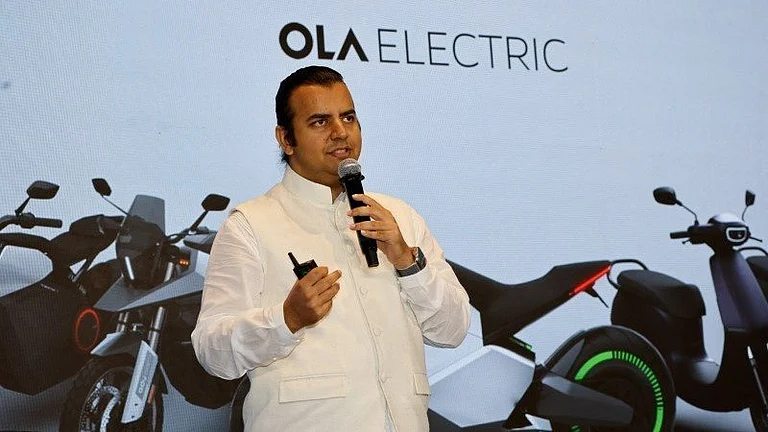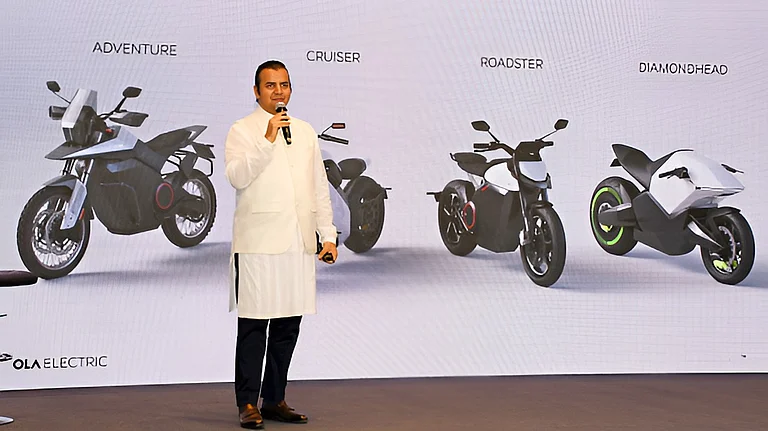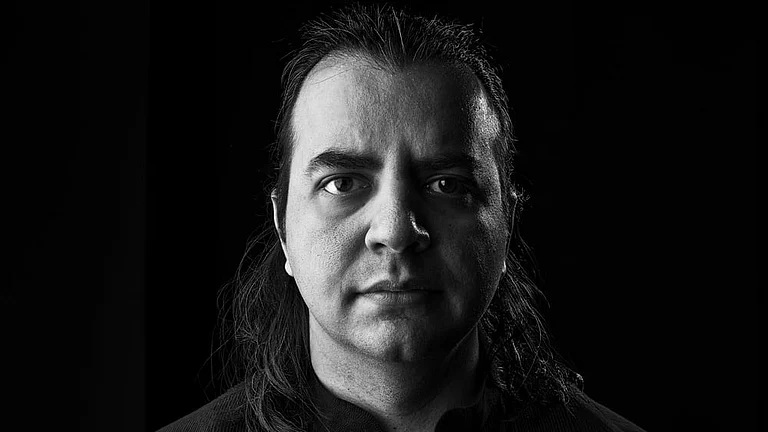You have always been a risk taker. Has there ever been a moment where you've doubted yourself?
Why does the world think I'm a risk taker? I don’t think I am. I take calculated risks, not blind risks. Fundamentally every entrepreneur takes some risks, it is about how well you can think it through. And how well you know your domain to predict its possibilities.
We will not achieve the Viksit Bharat dream unless we take some risks. You know, in 1996 APJ Abdul Kalam, who I admire deeply, wrote in his book that India will be a developed nation by 2020. But that did not happen.
So, similarly today, if we feel that it is a given that India will be developed by 2047, it will not happen automatically but only through tapasya and hard work. Every stratum of society will have to contribute to it. And that journey is one of risk taking. And the more thoughtful, calculated risks we take, individually and collectively, the better for our country.
With Ola Electric you’ve entered India’s core two-wheeler manufacturing sector that has been dominated by legacy players. What gives you the confidence to have the conviction in this risk where you are an outsider?
I have always been an outsider in everything I have done. [My] confidence comes from intelligence and preparation. Whenever we enter a domain, we really go deep into it. At Ola for electric vehicles [EVs], I went around the world to meet EV companies. I saw their plants, their cell plants. I spent time in just preparing myself for that domain, understanding the reasons that would make EVs a success in India. I am a technologist, so I spent a lot of time understanding the technology that goes behind making EVs. I spoke to many engineering leaders. Only after spending over two years in learning about EVs did I figure our opportunity in it. So, it is a calculated risk for me. And for me conviction is more important than confidence.
I don’t doubt myself when taking a risk. You are afraid if you are not clear about your purpose. I am very clear about Ola's purpose or as our scriptures say, our swadharm, which is to use technology to build towards India's vision of development.
But obviously sometimes on the flip side, I have taken decisions which have not played out. Like when we started the food delivery business five years back, we were too late and other companies like Swiggy and Zomato were already there, and we were not bringing anything new to the table.
So now when we have restarted with ONDC [Open Network for Digital Commerce] it’s a different model and it’s a technology-oriented one. So, it is a risk. But now there is more conviction because we have spent time understanding it. We brought our unique secret sauce to it, which is technology.
Apart from technology, do you also draw your confidence about Ola Electric from your strategy to vertically integrate the business?
EV technology is a once-in-a-generation transition in mobility. After a hundred years, we are moving away from internal combustion engines [ICEs] to EVs, lithium cells and electric motors. So, when technology changes, the entire business model changes. And hence companies who create technology in-house do better than those who outsource and only assemble the products.
We created a business model which involves vertically integrated manufacturing and vertically integrated distribution to amplify the benefit of building technology in-house. And because we understand how technology is built across the stack from motor technology, software, electronics, lithium cell, automated robotics manufacturing, it gives us a lot more control over the process and hence a lot more confidence.
I don’t doubt myself when taking a risk. You are afraid to take risks if you are not clear about your purpose. I am very clear about Ola's purpose
What is your biggest motivation?
To make in India and make India a developed nation.
As an entrepreneur you may be motivated to work 70, 80 hours a week. But how do you keep your employees motivated?
Isn’t the average Japanese better off today because his previous generation worked hard? It’s not just 10 business owners who are better off. Isn’t the average German proud of where his country has reached and having a better lifestyle because of what the previous generation did?
So one generation must do the tapasya. And in India that is our generation, and we cannot run away from it.
Gen Z prioritises work-life balance so when entrepreneurs like you or NR Narayana Murthy talk about working 70 hours a week, it creates a lot of controversy.
I feel Gen Z wants a purpose in life not an easy life and it is incumbent upon us to inspire them to be part of this national mission. At Ola we have about 12,000 employees as a group, all of them are inspired to working towards our mission. And that doesn't mean everybody works 100-hour weeks, but we all work hard. Look at how many start-ups that are being incubated by young people. So, this is a generation which wants a purpose in life. They are not driven by the need to have a certain salary to de-risk their life, which was the case with our parents’ generation. They worked hard for roti, kapda aur makaan and we had the benefit of that.

Let’s go back to the swadharm that you spoke about. How has your founding vision changed as you moved from a cab-hailing platform to manufacturing to Krutrim?
You know, when I founded Ola, I was a 24-year-old kid. So, I didn't have a founding vision. (Laughs)
For an entrepreneur, it is actually a journey of discovering oneself. As you grow, you also evolve and fundamentally you also learn more about yourself. When we started off in 2010, India was at a stage where our economy was starting to grow fast and those were the early days of the start-up movement. I wanted to be part of this.
Look at the world today, there are two major transformations or revolutions happening right now. One is a technology revolution with AI [artificial intelligence], EV, space tech creating disruption all around.
And second is the new world order that is being created, where we need more resilient supply chains, new thought leaders and a new definition of capitalism. This is India’s moment; a young country growing into this opportunity from an economic, geopolitical and philosophical lens. I have understood all of this as I’ve gone along, and so my swadharm has evolved, because what I bring to the table is technology, risk taking, entrepreneurship and execution. And this is the opportunity around me.
What does the success of Ola Electric listing mean for the entire sector?
I think Ola Electric is the vanguard of the EV revolution. Till the day before the IPO [initial public offering], a lot of the incumbents were saying all sorts of things. Some of these incumbent companies were very dismissive. And they had to eat their words. Abhi toh game shuru hua hain [The game has just begun]. Other players have also entered the arena now but as they say, “Maidan mein aye hain par balla leke nahi aye hain [They came to the ground but did not bring their bats]”. (Laughs)
What went into the pricing decision when you were listing? If Paytm had not listed before you, would you have been this sensitive about pricing?
I have always been very valuation agnostic. At a point in our Ola journey some of our investors wanted a different direction for the company’s future vis-vis me, so we have done down rounds in the past in some of our companies. So, for me valuation is just a number. I believe in value creation, not valuation. We wanted to price this IPO in a way that the public market investors see long-term journey with us.
Markets want value creation and not disruption. So, will listing stop Bhavish Aggarwal from being a risk taker, a disruptor?
Many of my advisers also told me this but I disagree with that. The markets want to protect value, but they also want growth. The whole market is growing at a rate because it reflects a vision for the future and has an inherent risk-reward equation within it. So, they want to understand risk more than avoid risk. So, it is incumbent upon me, the entrepreneur, to communicate understanding of risk to the markets and be pragmatic to take only as much risk as we can handle.

As a new-generation Indian manufacturer, what are the areas of innovation that you have in front of you?
I think the future of Indian manufacturing is to build products of the future using advanced manufacturing technologies. India should become a more confident participant in global trade. Instead of approaching global trade from a defensive position, we should approach it from an offensive position.
EV in itself is a bunch of innovations put together. One of the most iconic innovations we are doing is the Bharat cell. The cost of the battery is 30–40% in an EV. In the ICE era, companies that were successful had complete control over the engines, because that was the most important part of the car. In the EV era, those companies that will make the battery themselves will become global leaders. Ola Electric is making its own battery through Bharat cell.
If India wants to become a developed nation by 2047, it needs to be a manufacturing powerhouse. But don’t you think that India faces systemic challenges like land acquisition and labour issues?
I disagree with this narrative that India is a tough country to manufacture in. We have put two factories on ground now and it took us only 7–8 months. And these are large factories. From land acquisition to construction to labour, everything was smooth for us. India may not have the most streamlined set of labour laws, but if there’s a will, you can find your way. I believe that it is scarcity of capital that comes in the way of India’s manufacturing dream. Historically, not enough domestic capital has gone into manufacturing in India, because maybe as a country we were focused on the services sector.
While automotive manufacturing creates jobs, but chip making, which the government is incentivising does not. How can we strike a balance?
India is so huge that we must get all the things together, keeping in mind job creation as well as the country’s geo-strategic interests that would be served by getting into chip manufacturing. The government has done so much to promote manufacturing in India in the past few years, now it is the turn of the private sector to invest capital.
Not land or labour issues...I believe that it is scarcity of capital that comes in the way of India’s manufacturing dream
Much of the EV supply chain is rooted in China. What should we do to mitigate the risk emanating from that part of the world? And is there a possibility of your project getting sabotaged by global powers?
There is nothing worthwhile in the world which you don't have to fight for. Individually or collectively. So much sabotage has happened against me not by global companies but by domestic ones. But it’s okay.
Sometimes I hear people saying, “We believe in the India story.” But that is for the white man to say. We must create the India story. Nobody else will do it on our behalf. We have to fight for our country’s place in the world and contribute as much as we can. You are right in saying China controls the energy supply chain. We need to appreciate [the fact] that they invested in this vision 20 years ago.
How can India de-risk the dependency on China for EV batteries?
In the case of India, we have a very large domestic market. We have to use the scale of the domestic market to build our own midstream supply chain. That’s how we started at Ola. First, we built a reasonable scale, now we’re building the cell itself. Once the cell gigafactory is ready and scaled up, we will get the midstream into India and not rely on China. India needs to also do global trade partnerships to get the raw materials from the right countries, like the Indian government has done with Australia.
You are also betting on AI. From ride hailing to manufacturing to AI, what are the synergies?
The digital economy today is not just about apps and websites. It is also about AI, chips and data centres. India generates the largest data in the world, but all of it is sitting in the West. And then they take our data out, they process it into AI, and then they bring it back and sell it to us. It's the same East India Company all over again. I call it techno-colonialism.
How do you plan to change it?
Every diamond in the world goes through Surat. Every chip in the world has enough content built in Bengaluru, Noida, Hyderabad or Pune; but there is no Indian chip. India has the largest number of silicon designers in the world, the largest number of developers. But most of them are in global capability centres, not really focusing on building for India. And India is the largest market in the world for developers. But again, we are not using Indian development platforms. AWS, Azure, Google, all of them sell their products at the same dollar rate at which they sell to the US. So, we need a new paradigm. And that's what Krutrim wants to build. Krutrim wants to build a platform for Indian developers, silicon designers, app developers to be able to build more profitable, scalable business models.
Now that you are a publicly listed company, how do you plan to manage the issue of customer dissatisfaction that is often visible on social media and other platforms?
We have scaled up very fast in the past couple of years and even in the last one year, our sales have gone up, say 100% year-on-year. In the process of scaling up, our service network has lagged a bit. We have about 500-odd service centres to 800 sales stores. You can see the gap. But now we are trying to catch up as fast as we can.
We are also opening up both sales and service networks. So independent mechanics can also service Ola scooters as they can buy parts from our network.












